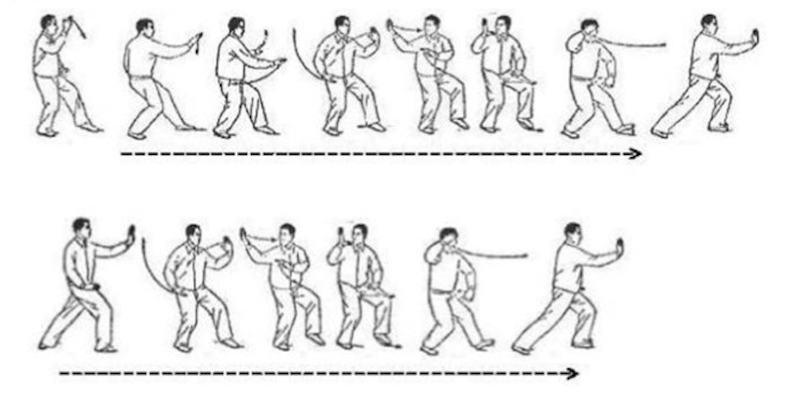Brush Knee Twist Step
Taken from 'Illustration of five tai chi movements. (A) Brush Knee and Twist Steps…' in Effects of tai chi program on neuromuscular function for patients with knee osteoarthritis: Study protocol for a randomized controlled trial - Scientific Figure on ResearchGate. Available from: https://www.researchgate.net/figure/Illustration-of-five-tai-chi-movements-A-Brush-Knee-and-Twist-Steps-B-Playing-the_fig2_258334971 [accessed 30 Aug 2024]. Image Creative Commons.
In our school we call this one ‘brush knee push’.
I stumbled across Master Gu’s video below after falling down my usual YouTube rabbit hole.
We also tend to drill this regularly, but I can’t say I am anywhere up to a 1000 times a day!
Key points
His bow stance is long and low, shorter than I was taught (but closer to what I actually do!)
The rear stepping foot does come into the front foot (crescent moon shape), but not in an overly pronounced way
He makes a point of coordinating the hand, eye and body - particularly in the latter part - where you can see him looking at, and watching his rear hand as it moves forward.
The higher pushing hand is palm down as it travels past the face. I am used to doing it with the palm toward my face, ‘spear past the ear’).
The pushing hand arrives a fraction later and after the step. I have conditioned myself, rightly or wrongly, so that my three moving limbs come to rest in time with each other, and the effort of the push is then driven from the same-side supporting leg.
The pushing hand is face height when it finishes moving. I am used to seeing it drop to chest height and suggest placing the palm of the heel in the solar plexus
There is a distinctive turn of the body - left, centre, right etc. - it’s not just the arms and hands moving
He does not make a big deal of ‘holding a ball’, it’s very subtle, if there at all
Inhale to prepare, exhale when stepping
Footnotes
Master Gu is a ‘Wudang’ Tai Chi practioner. Wudang refers to the mountain range in China where many traditional Chinese martial arts are practised. From a philosophical perspective he uses the term ‘Taoist’ Tai Chi. He describes his Tai Chi as being physically closer to Yang style than Chen. See this video for more https://www.youtube.com/watch?v=zPc6p1xS5KY
When I started researching for this article, I immediately found Graham Barlow’s 2019 post, and want to credit it here as I know he is experiencing a lot of plagiarism and wholesale theft of content from his site - https://thetaichinotebook.com/2019/03/25/brush-knee-twist-step-tai-chi-application-and-style-comparison/
I guess there is nothing ‘new’ to write about in Tai Chi? 😄
Revision history
11-Oct-2025 - added additional clarifications and observations, mainly highlighting differences to the way I have learned and perform the move. Master Gu’s way is clearly graceful and beautiful!

